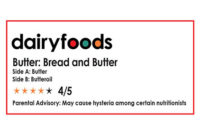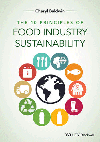State of the Industry 2008: From Private Label to Foreign Trade
The dairy industry is complex and dynamic, so as 2008 ends we take a
close look at every dairy category, including sales and product
launches.

While raw milk prices have begun to moderate in recent months, 2008 may end up being remembered as offering more of the same as 2007, in terms of higher commodity prices being passed onto consumers. Again this year, the result has been higher dollar sales, but also sluggish volume sales numbers at retail.
One of the big differences in 2008 is that the price of everything (not just gasoline and milk) is higher for the consumer. Most recently, with the meltdown in the banking sector knocking the rest of the economy out of sync, consumers are considering every purchase in an entirely different context. We can anticipate what that will mean for the food and dairy industries in particular-fewer out-of-home purchases, some opportunity for value-priced, private label and comfort food, for instance.
The following State of the Industry Report is a snapshot of statistical data for each of the main dairy segments (and then some) along with trend analysis from the Dairy Foods/Dairy Field Reports staff, and our research partners at Mintel International, Chicago.
U.S. dairy processors have more raw material than ever at their disposal. USDA reports that milk production increased 2.1% in 2007 to 186 billion pounds. Cash receipts from milk during 2007 totaled $35.4 billion, 51.4% higher than 2006.
But while dollar sales are up, unit sales are down, the result of consumers’ tough choices in a tough economy. As Miriam Erickson Brown observes, “We see consumers in every market making alternate beverage choices and downsizing from gallons of milk to smaller sizes out of budgeting necessity.”
Yet Mintel foresees milk’s dollar sales continuing to grow over the next five years, driven by product and packaging innovation as well as price increases. And with prices rising, processors will have to deliver additional value to justify the cost.
Total cheese production was 9.70 billion pounds, 1.8% above 2006 production. At retail, natural cheese has surpassed processed cheese and it is growing while process cheese declines.
Convenience spells growth with natural shreds and slices growing, and moving into private label. Looking at product development, there are more probiotic, organic, specialty and artisan cheeses being introduced.
Overall ice cream production is down. According to USDA, 951 million gallons were made in 2007; that’s a 3.2% decline. Yet Mintel reports a 20% climb in dollar sales over the past five years. With household penetration close to universal, ice cream remains a consumer favorite. Meanwhile, consumers wrestle with the dilemma of indulgence versus moderation, a need being met by portion-controlled novelties and churned-style products.
In the cultured products segment, yogurt continues to be the big story, but there are smaller successes to be noted in cottage cheese, sour cream and dips. In some cases these products are offering more health function.
Butter production in the United States during 2007 totaled 1.53 billion pounds, 5.8% above 2006, USDA reports. While not a dynamic category, butter has benefitted recently from the backlash against trans fats found in many non-dairy spreads. Butter is attempting to take advantage of other qualities that its competitors don’t possess.
Many dairy processors manufacture and sell other beverages, so with some help from Beverage Industry, we look at the various beverage categories. And processors use a lot of other ingredients, flavors and colors to produce its full array of products, so we have a comprehensive report on ingredients.
Finally, these products must be sold. Retail sales and food service are the backbone of dairy marketing, but in recent years, trade to the export market has begun playing a larger role. We’ll explore that growing export market and recognize the Dairy Foods/Dairy Field Reports Exporter of the Year, Wisconsin-based Schreiber Foods.

While raw milk prices have begun to moderate in recent months, 2008 may end up being remembered as offering more of the same as 2007, in terms of higher commodity prices being passed onto consumers. Again this year, the result has been higher dollar sales, but also sluggish volume sales numbers at retail.
One of the big differences in 2008 is that the price of everything (not just gasoline and milk) is higher for the consumer. Most recently, with the meltdown in the banking sector knocking the rest of the economy out of sync, consumers are considering every purchase in an entirely different context. We can anticipate what that will mean for the food and dairy industries in particular-fewer out-of-home purchases, some opportunity for value-priced, private label and comfort food, for instance.
The following State of the Industry Report is a snapshot of statistical data for each of the main dairy segments (and then some) along with trend analysis from the Dairy Foods/Dairy Field Reports staff, and our research partners at Mintel International, Chicago.
U.S. dairy processors have more raw material than ever at their disposal. USDA reports that milk production increased 2.1% in 2007 to 186 billion pounds. Cash receipts from milk during 2007 totaled $35.4 billion, 51.4% higher than 2006.
But while dollar sales are up, unit sales are down, the result of consumers’ tough choices in a tough economy. As Miriam Erickson Brown observes, “We see consumers in every market making alternate beverage choices and downsizing from gallons of milk to smaller sizes out of budgeting necessity.”
Yet Mintel foresees milk’s dollar sales continuing to grow over the next five years, driven by product and packaging innovation as well as price increases. And with prices rising, processors will have to deliver additional value to justify the cost.
Total cheese production was 9.70 billion pounds, 1.8% above 2006 production. At retail, natural cheese has surpassed processed cheese and it is growing while process cheese declines.
Convenience spells growth with natural shreds and slices growing, and moving into private label. Looking at product development, there are more probiotic, organic, specialty and artisan cheeses being introduced.
Overall ice cream production is down. According to USDA, 951 million gallons were made in 2007; that’s a 3.2% decline. Yet Mintel reports a 20% climb in dollar sales over the past five years. With household penetration close to universal, ice cream remains a consumer favorite. Meanwhile, consumers wrestle with the dilemma of indulgence versus moderation, a need being met by portion-controlled novelties and churned-style products.
In the cultured products segment, yogurt continues to be the big story, but there are smaller successes to be noted in cottage cheese, sour cream and dips. In some cases these products are offering more health function.
Butter production in the United States during 2007 totaled 1.53 billion pounds, 5.8% above 2006, USDA reports. While not a dynamic category, butter has benefitted recently from the backlash against trans fats found in many non-dairy spreads. Butter is attempting to take advantage of other qualities that its competitors don’t possess.
Many dairy processors manufacture and sell other beverages, so with some help from Beverage Industry, we look at the various beverage categories. And processors use a lot of other ingredients, flavors and colors to produce its full array of products, so we have a comprehensive report on ingredients.
Finally, these products must be sold. Retail sales and food service are the backbone of dairy marketing, but in recent years, trade to the export market has begun playing a larger role. We’ll explore that growing export market and recognize the Dairy Foods/Dairy Field Reports Exporter of the Year, Wisconsin-based Schreiber Foods.
Links
- State of the Industry 2008: Cheese is Convenient, Naturally
- State of the Industry 2008: Ice Cream--Sweet Success
- State of the Industry 2008: Yogurt Still the Bright Spot
- State of the Industry 2008: Butter--Spreading What's New
- State of the Industry 2008: Changes in the Big Beverage Market
- State of the Industry 2008: Ingredients--Pricey Necessities
- State of the Industry 2008: Milk--Ups and Dows
Looking for a reprint of this article?
From high-res PDFs to custom plaques, order your copy today!









